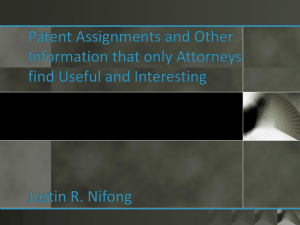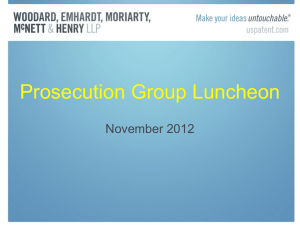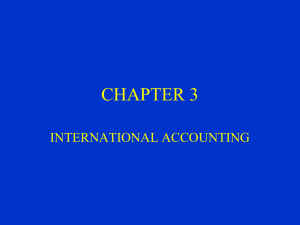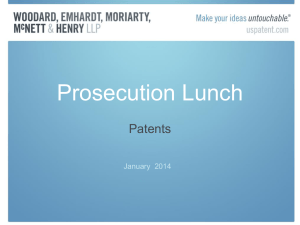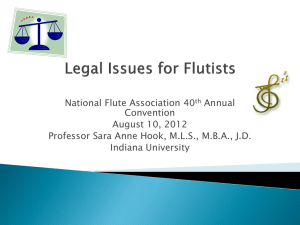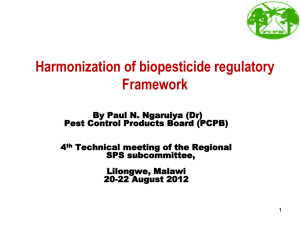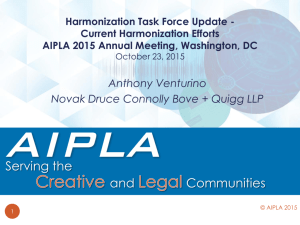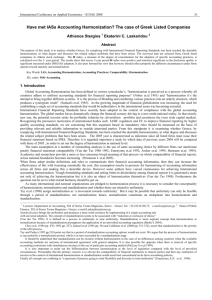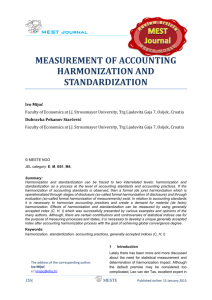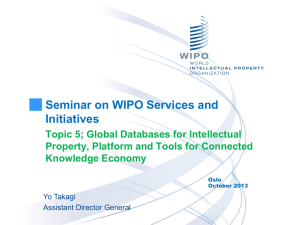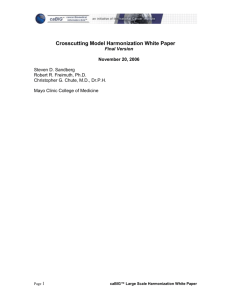POLICY April 28-29, 2011
advertisement
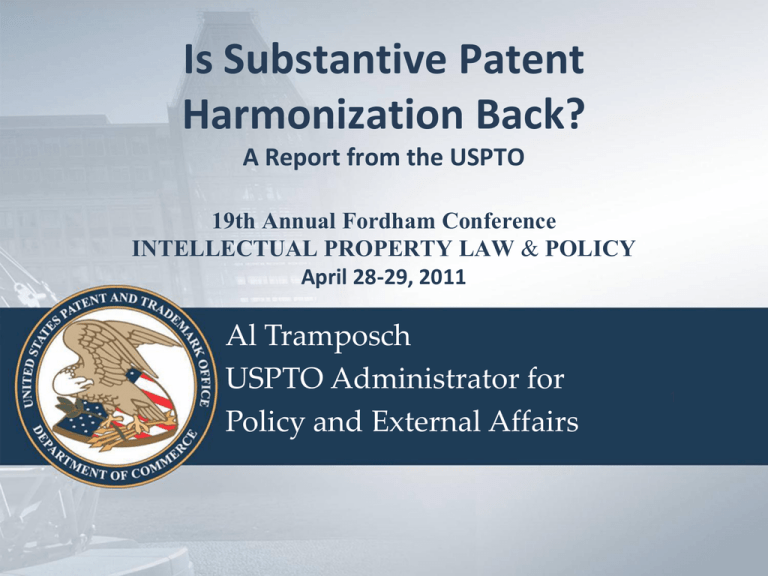
Is Substantive Patent Harmonization Back? A Report from the USPTO 19th Annual Fordham Conference INTELLECTUAL PROPERTY LAW & POLICY April 28-29, 2011 Al Tramposch USPTO Administrator for Policy and External Affairs 1 Office of Policy and External Affairs Objectives: Teams: Provide Domestic Leadership on IP Policy & Development of a National IP Strategy Provide Leadership on International Policies, Improving Protection and Enforcement of IP Rights Policy Patents Trademarks Copyrights Trade Enforcement Governmental Affairs IP Attaches Chief Economist Global IP Academy 2 IP: Turning Ideas into Jobs The Obama Administration Has Put Priority on Innovation and Technology Strategy for American Innovation, Sept 2009 IP as a driver of economic growth and job creation. Start Up America Economic and Social Imperative Global Recession Need to Spread Technology Across Borders • Open Markets • Bring Life-Saving Technology to those in need 3 Outdated Misconceptions Harmonization is not a “four letter word” Harmonization is about adopting best practices that make good sense for all offices and users This is not a zero sum game. It is not about negotiating trade-offs of aspects of existing patent systems. It is not about pitting developed versus developing countries. It is about creating a better system that improves access to technology, lowers costs, & streamlines procedures for all. 4 The Need to Modernize Outdated Patent Laws Patent laws are stuck in the last century They are out of phase with a global technological and commercial system extending seamlessly across borders Laws and procedures are still hopelessly mismatched from country to country The patent system, ironically, is a laggard among commercial legal regimes. It will never live up to its potential until it is harmonized. 5 The Economic and Social Imperative Solving the Global Recession requires innovation on many levels Technological innovation to spur economic growth and jobs Systemic innovation to do things in a new and different way, that works in the 21st century Need to Spread Technology Across Borders • Far from being a barrier, IP is a sine qua non of international technology transfer • It can open markets, including technology markets • It can bring life-saving technology to those in need 6 The Time for Harmonization is Now USPTO is acting on a vision of an IP world in which the national systems are harmonized in pursuit of optimal innovation and optimal diffusion of innovation on a global basis. The Fragmented International System Increases Costs and Decreases Certainty Forestalls Innovation and Economic Growth Industry believes harmonization is long overdue The US Congress is Ready to Act 7 A Brief History: Harmonization Issues Traditional “Harmonization" Issues First-inventor-to-file Grace period Definition of prior art The Hilmer doctrine Secret Prior art used for Novelty only, or also for Nonobviousness Definition of novelty Definition of non-obviousness/inventive step Disclosure requirements, including best mode 8 A Brief History: PCT and PLT 1991 Patent Cooperation Treaty (1970) Facilitated international applications Provided an extended timeline for entering examination phase Standardized certain procedures and processes PLT – Hague Diplomatic Conference (1991) Built on WIPO Committee of Experts process, initiated in the mid-80’s Failed on first-to-file issue 9 A Brief History: Procedural PLT and SPLT Procedural Patent Law Treaty (PLT 2000) Intended to fill the gap until substantive harmonization could be revived Included, inter alia, the concept of a single form for national and PCT applications Substantive Patent Law Harmonization (SPLT) Substantive discussions were revived at WIPO in 2001 Stalemated by development issues 10 A Brief History: Group B+ Stalemate at WIPO led to establishment of “Group B+” Initiated by the USPTO in 2005, originally called the “Alexandria Group” Included EPO and EU member states, US, Japan, Canada, Australia, New Zealand Progress stalled on issues of grace period and 18month publication Put on ice in 1997, pending U.S. patent reform and revival of interest 11 In the Meantime: Worksharing Fruitful discussions are taking place in the context of the Trilateral Office (USPTO, JPO, EPO) discussions, and IP5 (Trilateral, plus Rep. of Korea and People’s Republic of China) Common Citation Document; Ten Foundation Projects Bilateral negotiations have lead to a successful “Patent Prosecution Highway” (PPH) Accelerated examination in a second office, based on successful examination in the first office Expanded to “PCT-PPH” 12 USPTO Initiative in 2011 In an effort to re-energize interest in substantive patent harmonization, the USPTO hosted the “Asia-Pacific Patent Cooperation Forum for the 21st Century”, March 7-8, 2011, in Alexandria, VA Informal discussions among like-minded economies, including interested developing countries, led by Heads of Offices “Our efforts today are about beginning a substantive dialogue to put patent law harmonization back on track. They’re about collaborating on what makes the most sense for our shared global currency of innovation in the 21st century.” USPTO Director David Kappos, Opening Remarks 13 Taking the Discussion Global Director Kappos is engaging in discussions to bring the re-energized discussions global, including European and other jurisdictions that were not involved in the APPC meetings All countries that are interested in making progress will be included The effort will be lead by Heads of Offices, and supported by technical working group of experts 14 Looking to the Future From the Statement of the Participants at the APPC Forum: “The time for substantive harmonization is now. We are operating in a global economy, business innovation is happening across borders. The IP system needs to be supportive of this new reality.” 15


